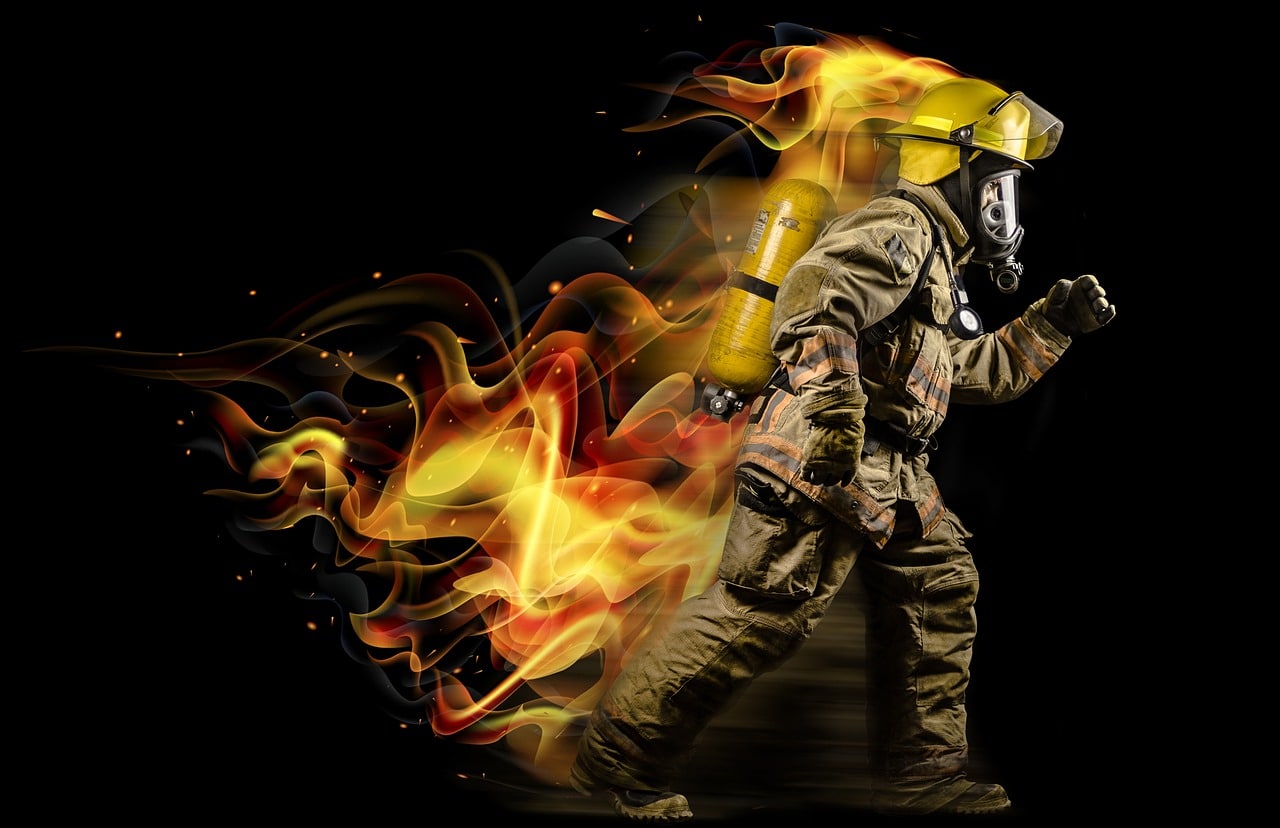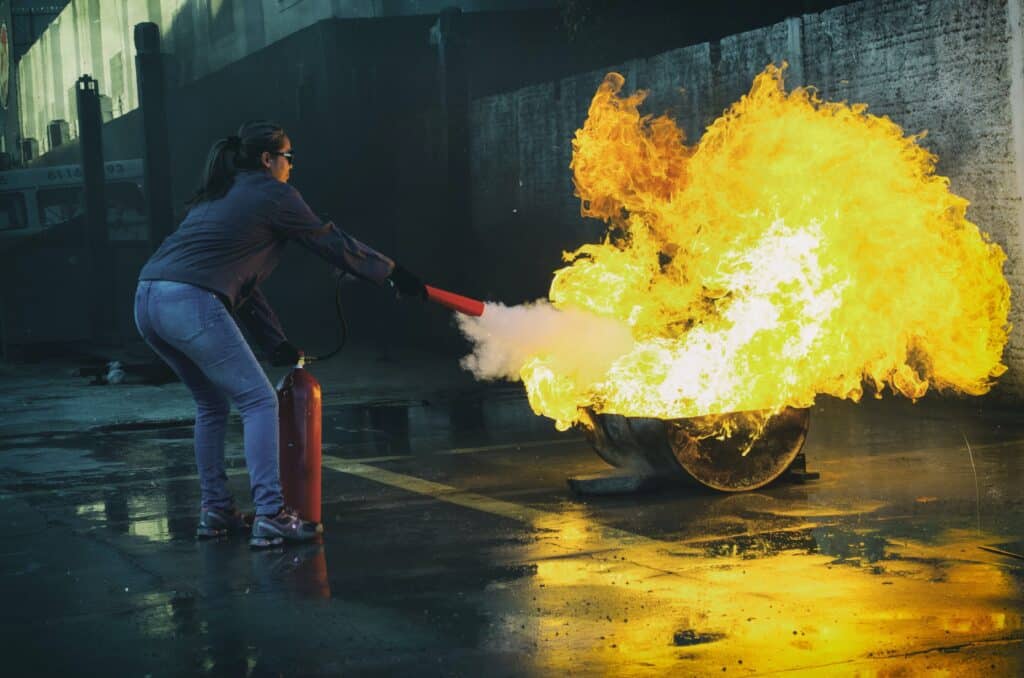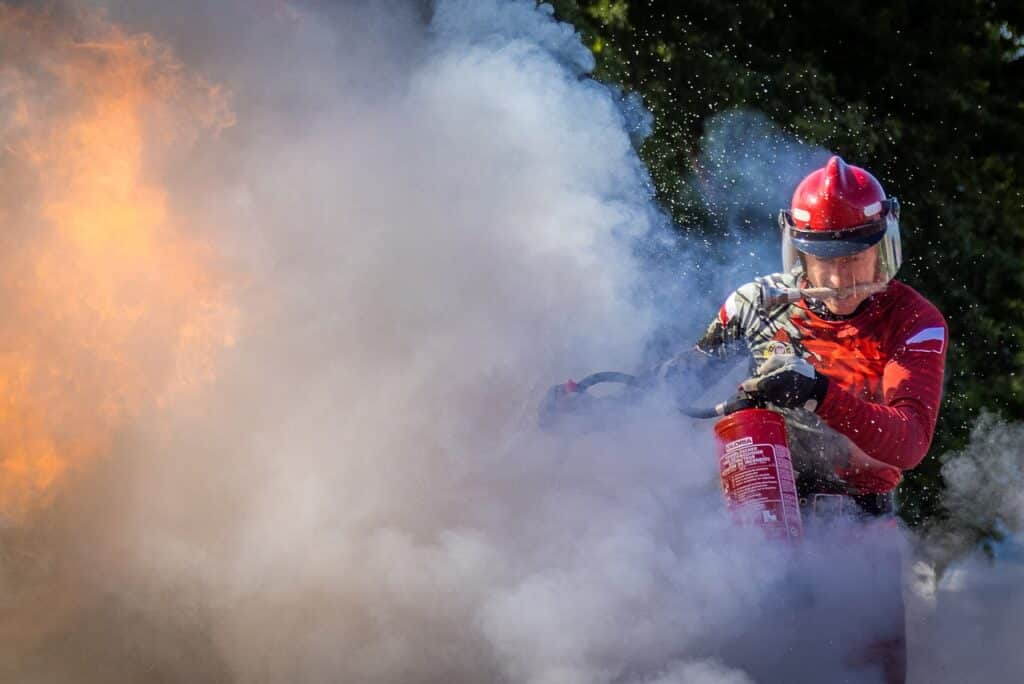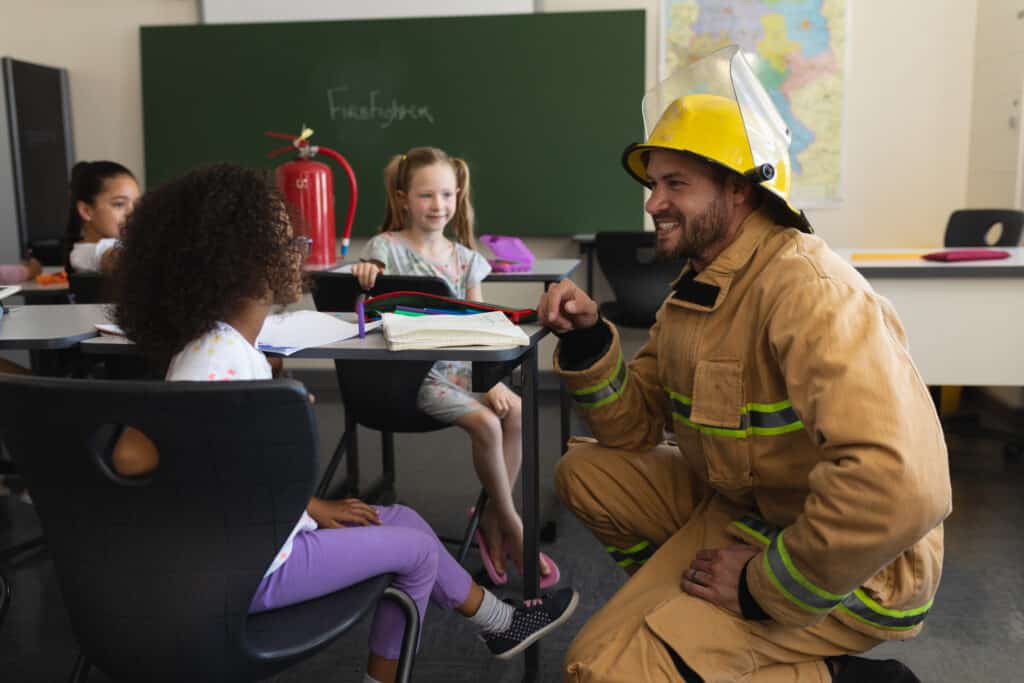Fire Safety Training for Employees: Essential Trainings and Legal Requirements

Fire Safety For Employees
Employees at all levels require thorough fire safety training to ensure they can respond calmly and correctly in an emergency evacuation.
Providing employees with thorough fire safety training is a crucial responsibility for employers.
All workers should receive role-appropriate instruction covering fire risks, prevention, response plans, and hands-on practice to protect themselves and property in a fire emergency.
This article explores the key knowledge areas, commonly asked questions on fire safety and fire training, and legal duties regarding fire training for staff across industries like offices, retail, healthcare and more.
We will examine why diligent fire drills and ongoing reinforcement of protocols is indispensable for ingraining readiness to protect lives and property.
Table of contents
- Understanding Basic Fire Training for Employees
- What Fire Training Should Be Given to Employees?
- What is Included in Fire Safety Training?
- How Many Staff Need To Be Fire Trained?
- When Should New Staff Complete Fire Training?
- Should All New Staff Have Fire Training Within?
- Do Employers Have to Provide Fire Safety Training to All Staff?
- Which Staff Members Should Attend Fire Safety Training?
- Choosing the Mode of Learning
- Legal Requirements for Fire Safety Training in the UK
- Fire Training Needs for Diverse Business Types
- Training Employees for Fire Safety
- Fire Warden Training for Employees
- Fire Safety Training in Care Homes
- Important Fire Safety Tips for Staffs and Businesses
- Fire Safety Training: An Ongoing Obligation
- Fire Safety Training for Developmentally Disabled
- Relevant Articles
Understanding Basic Fire Training for Employees
Fire training provides staff with crucial knowledge on fire risks, prevention, equipment use, and emergency protocols.
Lessons cover:
- Fire chemistry and behavior – how fires ignite, spread, and are controlled
- Operation of fire suppression systems like alarms and extinguishers
- Proper fire reporting and notification procedures
- Safe evacuation techniques and assisting mobility impaired
- Post-fire response like damage control and investigation
- Ongoing fire precautions like hazard monitoring
The goal is developing skills and instinctive response capabilities to address fires rapidly and effectively. Training is adapted to different workplace environments and employee duties.
What Fire Training Should Be Given to Employees?
Comprehensive fire training for staff should include:
- Fire chemistry – Components of fire, how it starts and spreads. Understanding how to remove fuel sources and properly handle flammables reduces risks.
- Potential ignition hazards – Identify hazards like electrical issues, equipment malfunctions, hot works, smoking, combustibles. Developing hazard awareness helps prevent fires.
- Fire prevention – Good housekeeping, proper storage of flammables, regular equipment maintenance, adherence to all fire codes and safety rules. Fire prevention is key.
- Fire Detection systems – How and where to manually activate fire alarm pull stations. Recognizing alarm signals. Familiarity with automatic detection speeds response.
- Suppression equipment – Instruction on available systems like sprinklers and special hazards protection specific to the facility. How to access fire extinguishers and use PASS method. Hands-on fire extinguisher demonstration training to boost confidence and proper use in the event of incipient stage fires. Understanding the capabilities and limitations of available equipment.
- Evacuation training – Escape routes, signage, contingency plans, meeting locations. Practice via fire drills. Special evacuation methods for mobility impaired individuals. Ensuring familiarity with emergency protocols.
- Emergency procedures – When and how to call emergency services. Information to accurately convey. Communications protocols during crisis.
- Special role duties – Additional instruction for those assigned special responsibilities like site fire wardens who assist others or handle critical systems during evacuations.
- Follow up education – Refreshers should happen annually at minimum, as well as when procedures change. New employee orientation should include fire safety basics.
Fire training empowers workers to stay vigilant, respond correctly when fire strikes, take appropriate initial suppression action if safe, and evacuate in an organised manner.
CLICK TO BUY- ONLINE FIRE SAFETY COURSE- INSTANT CERTIFICATE DOWNLOAD
What is Included in Fire Safety Training?
Typical modules in workplace fire training programs to prevent workplace fire hazards are:
- Fire basics – Triangle of combustion, classes of fire, how fire spreads
- Common causes – Heat sources, electrical hazards, improper chemical/flammables handling
- Risk reduction – Housekeeping, storage, hot works precautions, fire-safe worker habits
- Fire detection systems – Manual pull stations, automatic alarms, smoke detectors
- Available fire suppression – Extinguishers, sprinklers, special systems
- Extinguisher use – PASS method, hands-on practice
- Emergency communications – Evacuation signals, contacting fire department
- Evacuation protocols – Escape routes, contingency exits, assembly points, assisting mobility impaired
- Special responsibilities – Sweeping area, critical operations shutdown, gathering at muster point
- Recordkeeping – Staff training documentation, fire drill logs
- Prevention mindset – Reporting hazards, asking questions.
The breadth reinforces understanding and motivation around fire safety.

Only 48% of UK businesses provide their employees with regular fire safety training. | 2022-20223
How Many Staff Need To Be Fire Trained?
Legally, all employees in a workplace should receive baseline fire safety instruction, regardless of position, full-time status, or assumed risk level of their role.
This establishes a universal understanding of risks and how to protect oneself and others in an emergency.
Beyond foundational training for all staff, more specialised instruction should be given to those with additional fire-related responsibilities like fire wardens, those handling:
- hazardous materials,
- performing hot works,
- working in high-risk areas, or
- assisting others during evacuation.
When Should New Staff Complete Fire Training?
New hires should complete basic fire safety training as part of their new employee orientation within the first week or two. This onboarding establishes a culture of prevention and gives new staff the ability to respond appropriately if an alarm or emergency occurred on day one.
Follow up hands-on instruction like fire extinguisher practice can happen within the first month as part of the probationary period. Scheduling group sessions periodically helps provide this critical hands-on training efficiently.
Regular day staff fire training or night staff training also needs to be considered and depending on the risk of the industry, necessary fire training would matter.
CLICK TO BUY- ONLINE FIRE SAFETY COURSE- INSTANT CERTIFICATE DOWNLOAD
Should All New Staff Have Fire Training Within?
Ideally, new employees should receive foundational fire safety instruction within their first 5 days.
Critical knowledge like alarm recognition, evacuation paths, responder contacts, and extinguisher locations equips workers to react correctly rather than freeze.
For staff in high-risk roles like those handling hazardous materials, working in dangerous environments, or with fire safety responsibilities, more in-depth instruction should happen in the first week also.
Do Employers Have to Provide Fire Safety Training to All Staff?
Yes, under UK fire legislation like the Regulatory Reform (Fire Safety) Order 2005, employers have an obligation to provide adequate, regular fire safety information and training to all staff members.
Failing to do so violates codes and puts workers at risk in the event of a fire emergency.
Which Staff Members Should Attend Fire Safety Training?
All employees should be included in facility-wide fire safety training initiatives regardless of position, schedule or assumed risk levels. Target audiences encompass:
- All individual contributors like administrative staff, consultants, technicians, engineers, sales associates and more.
- All levels of leadership – first-line supervisors through executive leadership. No exceptions for “office” roles.
- Full-time and part-time staff. Includes temporary/seasonal personnel.
- Field teams like sales reps who work offsite but visit the office location.
- Remote employees who work from home if they occasionally come onsite.
- Contractors, freelancers, vendors and other third-party affiliates regularly on premises.
- Volunteers like those supporting nonprofit organisations.
- Interns and students in training programs onsite.
A universal understanding of policies, equipment, routes, and responsibilities is vital to coordinate an organised response during a fire event.
Choosing the Mode of Learning
When it comes to training staff members, one of the biggest constraint is time. Training and retraining are very important and booking necessary schedules for fire training is important.
There are usually three mode of training that can be adopt by an organisation or an individual. These are:
- Online training
- Face-to-Face training
- Blended training: combine theoretical online fire safety training with face-to-face fire safety training for the practical component.
Consideration to make
Depend on the organisation, the choice of training mode for staff would be determined by:
- Role and Responsibility: If the role involves hands-on skills, practical demonstrations, and real-time decision-making, a face-to-face or blended approach may be more appropriate. If the emphasis is on theoretical knowledge without significant hands-on application, online learning might be sufficient.
- Learning objectives: For a well-rounded training experience, a blended learning approach is beneficial. If the training is focused primarily on theoretical knowledge or a specific aspect, online learning could be suitable.
- Team collaboration and communication: face-to-face or blended learning is effective for improving staff communication and team-building.
- Organisation preference due to time constraint: Consider the preferred learning style of participants. Some may excel in face-to-face interactions, while others may prefer the flexibility of online learning. Individuals with busy schedules or time constraints may find online learning more convenient, allowing them to progress at their own pace.
- Accessibility and Logistics: For participants in remote locations, online learning provides accessibility without the need for travel. Easy access to training location is also important.
- Resources Available and Training Facilities: How big or small is the training facilities and what are the equipment and resources available. Ensure you put that in mind when selecting mode of learning for fire training.

The Health and Safety Executive (HSE) issued a fine of £130,000 to a company in 2022 for failing to provide fire safety training to its employees. The company was found to have violated the Fire Safety Act 2005 by failing to provide its employees with adequate training on how to prevent and respond to fires.
Image Credit: Photo by Fritz Jaspers
Legal Requirements for Fire Safety Training in the UK
Under UK legislation, employers have clear responsibilities related to providing fire safety training in the workplace.
Failing to deliver adequate instruction puts workers at risk and constitutes a breach of regulations.
The Regulatory Reform (Fire Safety) Order 2005 requires employers provide adequate fire safety training to personnel based on workplace risk and roles.
Refresher education must also occur under the Order.
Is fire training a statutory requirement?
In the UK, fire training is required by law and it is important to adhere to fire safety regulations.
This means fire training for employees is something you have to do because the UK government mandates it.
It is equally important to learn about fire safety to keep yourself, your employees and everyone safe, especially in places like workplaces and public buildings.
So, yes, in many cases, fire training is a legal requirement. To understand the legal requirements, let’s proceed.
The Regulatory Reform (Fire Safety) Order 2005
The Regulatory Reform (Fire Safety) Order 2005 is the primary legislation covering fire safety duties in work environments across England and Wales. Within it, clear mandates exist around fire training:
– Employers must provide “comprehensive and relevant information” and “appropriate instructions and training” to employees regarding fire precautions in the building.
– Fire safety training should happen during working hours and at suitable intervals. It should reflect any new or altered risks.
– Instruction must cover appropriate procedures to follow in case of fire, including evacuation routes, summoning assistance, and use of firefighting equipment.
– Employers need to take special account of any workers particularly at risk such as disabled employees or those working in remote locations. Additional fire training may be warranted.
– Providers of temporary workers must ensure the workers have “adequate” fire safety training relevant to their assignments.
– Training should incorporate fire drills and involve all staff, contractors, and site visitors if warranted by their activities.
– Records should document the instruction, information, and training given to employees regarding fire safety procedures.
Specific regulations also mandate maintenance staff are trained in managing fire safety systems.
All employees need education on evacuation protocols and individual fire duties.
Failure to provide suitable fire safety training violates the Order.
Management of Health and Safety at Work Regulations 1999
The Management of Health and Safety at Work Regulations 1999 also impose a general duty on UK employers to provide workers with any necessary safety training during employment.
This would include fire prevention and response training where significant fire risks exist.
Organisations must make time and budget adequate fire safety training tailored to their facilities and emergency plans. Insufficient instruction endangers workers and exposes companies to sanctions.
Properly training staff is crucial for legal compliance and prevention.
While the frequency is not defined, annual refreshers are common since skills decay over time. Clear documentation of training is also legally required.
CLICK TO BUY- ONLINE FIRE SAFETY COURSE- INSTANT CERTIFICATE DOWNLOAD
Fire Training Needs for Diverse Business Types
While all companies require fire safety training, the specific focus areas should be tailored to the unique risks and situations of different business environments.
Training aimed at office fires will differ from that for industrial facilities for example.
Employers must provide instruction relevant to workers’ roles and settings.
1. Office Fire Training
Office personnel need training on:
- Locating exits, manual pull stations, fire extinguishers and knowing proper evacuation paths. High-rise training on emergency descent devices.
- Recognising and responding appropriately to fire alarms.
- Implementing orderly evacuation procedures, accounting for all staff and visitors.
- Calling emergency services when fire is confirmed. Providing building name, address and location of fire.
- Operating standard fire extinguishers if safe to make small efforts to suppress office fires.
- Maintaining good housekeeping in work areas to minimize paper and other fire load hazards.
- Following policies on appliances, open flames, space heaters and other ignition risks.
2. Retail Fire Training
Retail fire training should cover:
- Keeping aisles, exits and access to fire equipment unobstructed.
- Proper procedures for hot works performed during repairs/maintenance to avoid igniting materials.
- Correct use of any fire suppression systems protecting cooking or specialty areas.
- Regular cleaning to avoid dangerous lint and grease accumulation.
- Safe handling and storage of any hazardous retail materials per codes.
- Prompt reporting of electrical malfunctions that could spark fires.
- Facilitating orderly customer evacuation if fire event occurs.
3. Industrial/Manufacturing Fire Training
Industrial training includes:
- Mitigating ignition risks with electrical equipment, machinery maintenance, hot works permits.
- Ensuring adequate separation between incompatible materials and ignition sources.
- Operating specialized suppression systems matched to materials like flammable liquids or combustible dusts.
- Proper handling and storage of hazardous production materials and waste disposal.
- Reporting any equipment issues or damaged fire barriers needing repair.
- Adhering rigorously to hot work programs when welding, cutting, brazing, etc.
4. Healthcare Fire Training
Healthcare fire training covers:
- Operating fire-safe smoke hoods for patient evacuation if needed.
- Training night staff on additional escape routes and backup lighting systems.
- Fire-safe use of oxygen tanks and enrichment equipment.
- No smoking policies and safe smoking locations for staff and patients.
- Keeping fire doors closed or self-closing to prevent fire spread.
- Correct use of facility-specific suppression systems.
- Safe operating protocols for any equipment using heat or combustibles.
The most effective training applies fire prevention fundamentals to the specific environment involved for that business type and workforce.

Only 48% of UK businesses provide their employees with regular fire safety training. | 2022-2023
Training Employees for Fire Safety
Classroom lessons provide foundational knowledge on fire risks and protocols. But real-world drills are essential for reinforcing skills to make proper response instinctive.
Fire drill frequency varies on risk levels:
- Office buildings – Annually
- Retail/restaurants – Twice annually
- Care homes – Quarterly
- Hospitals – Monthly
Drills simulate real scenarios, prompting swift action and critical thinking. Staff reflect on gaps to drive improvement.
Training empowers employees to implement learnings like keeping exits clear and avoiding ignition sources. Workplace culture shifts as staff share ownership of fire safety.
Fire Warden Training for Employees
In addition to basic education, designated fire wardens require advanced instruction on duties like:
- Monitoring for fire hazards
- Maintaining safety systems
- Overseeing evacuation
- Coordinating drills
- Managing floor/zone evacuations
- Accounting for occupants after evacuation
- Reporting to emergency responders
Wardens need suitable authority and availability to serve effectively.
Fire Safety Training in Care Homes
Frequent fire training is paramount in care homes as delays risk lives. Quarterly drills ensure staff respond rapidly.
Care home fire training addresses challenges like mobility impairments. Techniques for manual evacuation of wheelchair users and other methods are practiced.
A 3-stage zonal evacuation is common:
1. Move all at-risk residents near exits
2. Relocate ambulatory residents next if more time allows
3. Finally evacuate all remaining individuals
This prevents leaving immobile residents trapped far from egress.
Conducting Fire Drills and Mock Drills
Realistic drills boost preparedness.
Steps include:
- Establish a scenario like a kitchen grease fire or arson
- Secretly simulate smoke using special machines
- Sound alarms triggering urgent evacuation
- Time response and completion of duties
- Provide observers to assess and report on gaps
- Debrief with employees on what went well and improvements needed
Mock fire drills ingrain instincts, unlike basic lectures. Proof of expression like using a fire extinguisher validates skills comprehension too.

Only 33% of schools provide their employees with fire safety training more than once a year. | 2022-2023.
Important Fire Safety Tips for Staffs and Businesses
1. Fire Safety Training for Kitchen Staff
Working in commercial kitchens carries unique fire hazards from ignition sources and combustible materials. Establishing safe practices protects the staff and business from devastating fires.
- Proper maintenance and cleaning of cooking equipment like stoves, ovens, and vents to prevent grease build-up.
- Keeping cooking areas free of combustibles and food debris.
- Safe handling of hot oil to avoid spillage igniting.
- Operating cooking equipment controls safely and proper manual gas valve shutoff.
- Avoiding loose fitting and rolled up sleeves when cooking.
- Correct use of fire suppression systems like automatic hood extinguishers.
- Keeping fire extinguishers and manual pull stations unobstructed.
- Thorough understanding of evacuation routes and protocols.
CLICK HERE- FIRE WARDEN TRAINING WITH FIRE EXTINGUISHER- CPD APPROVED
2. Fire Safety Training for Hospital Staff
Hospitals and care facilities have vulnerable patient populations reliant on staff to assist safe evacuation. Personnel must prepare for this responsibility through education on issues like:
- Complying with no smoking policies both personally and with patients.
- Safe operation of oxygen tanks and enrichment equipment.
- Proper use of fire blankets for patient evacuation if necessary.
- Maintaining access to hallways, exits and emergency equipment.
- Keeping fire doors closed or self-closing to prevent fire spread.
- Reporting any faulty or damaged fire safety equipment promptly.
- Proper handling and storage protocols for all hazardous chemicals and materials.
- Additional training for night staff on alternative escape paths and lighting.
3.Fire Training for School Staff
Schools have large occupant loads of students requiring assistance to exit safely in a fire. Teachers play a key role and should train on topics including:
- Maintaining access to exits from classrooms at all times.
- Reporting damaged orexpired fire extinguishers needing replacement.
- Keeping hallways clear of obstructions for safe evacuation.
- Safely storing any laboratory chemicals.
- Prohibiting unsafe electrical appliance use by students.
- Periodic instruction for students on fire risks, drills, and evacuation.
- Additional duties for teachers to assist safe student evacuation.
- Securing exits if fire noted to prevent re-entry until cleared.
4.Fire Training for Hotel Staff
Hotels must protect numerous guests who are unfamiliar with building layouts and egress paths. Staff education is vital and covers issues like:
- Identifying all stairwells and emergency exit routes clearly on maps
- Reviewing emergency descent devices for multi-story establishments
- Providing room evacuation maps and directions to guests
- Keeping hallways clear of housekeeping carts or linen
- Reporting any room smoke detector maintenance needs promptly
- Handling ignition sources safely like candles, irons, or cooking appliances
- Assisting safe evacuation for any mobility impaired guests if needed
- Calling emergency services with accurate building address if fire detected
The focus areas equip staff in higher risk environments to take appropriate precautions and respond correctly in a fire emergency.
Fire Safety Training: An Ongoing Obligation
In an ideal world, fires would never occur. But the reality is that commercial properties see over 44,000 fires annually in the UK.
Employers carrying out their legal duty to properly train employees on fire risks and responses is crucial for avoiding catastrophe.
Refreshing fire training annually, testing it via mock scenarios, and encouraging ongoing vigilance creates workforces ready for their vital role as an establishment’s first line of defense when fire strikes. We provided a blog post how often do staff require fire training.
Fire safety ultimately saves lives and livelihoods – an obligation no business can take lightly. The time invested in comprehensive training pays dividends when seconds count.

People with disabilities are two to three times more likely to die in a fire than people without disabilities. Training is key.
Fire Safety Training for Developmentally Disabled
Workplaces should take special care to provide fire education to any staff members who are developmentally or intellectually disabled.
Instruction should account for needs like:
- Simplified explanations of concepts at an appropriate level.
- Basic fire safety signage with clear unambiguous symbols.
- Physically walking evacuation paths and repeatedly practicing drills.
- Checking comprehension and providing supplemental visual aids.
- Patience and sensitivity delivering repeated instructions.
- Allowing hands-on manipulation of fire tools to understand their purpose.
- Customizing instructions to individual capabilities and learning styles.
All employees have the right to necessary fire safety knowledge. Accommodations help ensure disabled workers are also prepared and empowered to protect themselves.
How Do Disabled People Evacuate During Fires?
For mobility impaired staff, evacuation options include:
- Horizontal evacuation to an interior enclosed fire-rated stairwell or elevator bank lobby to await assisted rescue by first responders.
- Evacuation chairs allowing mobility impaired occupants to be wheeled down stairs. Workers must be trained on proper operation.
- Designating peer assistants who are assigned to help mobility impaired co-workers during emergency evacuation.
- Sheltering in place inside a room and sealing door edges with wet towels when evacuation is not feasible. Calling emergency services to notify location.
- For visual impairments, providing audible direction and guidance or a “buddy system.”
- Creating tip sheets explaining evacuation protocols in large print or braille for posting.
Reasonable accommodations enable safe emergency egress for all.
Fire safety training for all employees is both a legal obligation and wise investment.
Comprehensive instruction empowers workers to stay vigilant day-to-day, respond correctly when fire strikes, and assist fellow staff.
Workplaces that make ongoing education and practice a priority give their people the greatest ability to protect life and property should a fire ever occur.
Relevant Articles
- Basic Life Support Checklist -PDF Download Available
- Safeguarding Training Levels: How to choose the right training
- Caring For Care Partners with AquAid to Support Installation of Elephant Pumps in Africa
- Wound Assessment and Documentation: Mastering Key Steps for Better Care
- Understanding Bereavement Support and Duties of Different Healthcare Groups.
Let us Help you
We’ll help you find the right course for your needs. Tell us a little bit about your situation and what you would like to achieve.
We’ll get back to you within one working day.
